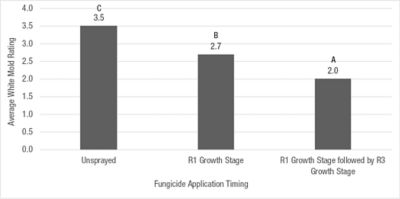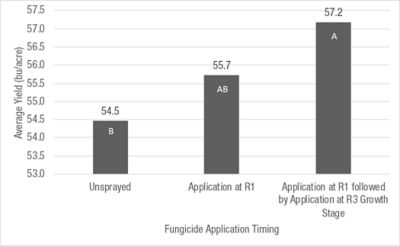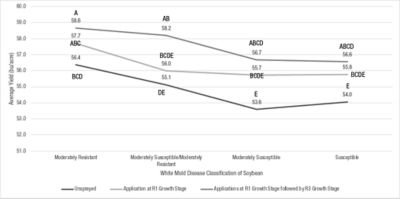10 MIN READ
Evaluation of Disease Management Systems in Soybean – White Mold
March 13, 2022
TRIAL OBJECTIVE
White mold (also called Sclerotinia stem rot) is a significant problem in the U.S. North Central soybean production region and in Canada. Caused by the fungus Sclerotinia sclerotiorum that overwinters in the soil, white mold is often recognized by fluffy, white growth on soybean stems. White mold development is favored by cool, cloudy, wet, and humid weather at first flowering. The disease tends to be more prevalent in soybeans in high-yield environments where high plant populations, narrow row spacing, and an early-closing canopy are commonly used.
The objective of this study was to evaluate a system-based approach for white mold disease management supported by genetic resistance of germplasm and foliar fungicide.
Select soybean products with varying levels of resistance to white mold were evaluated under different fungicide management options.
To compare yearly research data, click on a tab.
Evaluation of Disease Management Systems in Soybean – White Mold - 2021
RESEARCH SITE DETAILS
- Fields with a history of white mold were selected for this study.
- Plots were planted in a split-plot design with fungicide treatment as the main plot and soybean product as the sub-plot.
- Fungicide treatments included:
- Untreated
- Fungicide applied at R1 growth stage
- Fungicide applied at R1 and R3 growth stages
- The fungicide products used in 2019 and 2020 were Delaro® 325 SC fungicide (Group 3 + Group 11) at 8 oz/acre tank-mixed with Luna® Privilege Fungicide (Group 7) at 2 oz/acre at R1 growth stage. Delaro® Complete Fungicide (Group 3 + Group 7 + Group 11) was used at 8 oz/acre in 2021.
- Soybean products used were classified as susceptible (S), moderately susceptible (MS), moderately resistant/moderately susceptible (MR/MS), moderately resistant (MR), or resistant (R) to white mold.
- Resistant soybean products were left out of most yield data analyses because they were not planted in 5 out of the 18 locations.
- Plots were randomized within the trial.
- White mold disease ratings were taken at the R6 growth stage.
- 69 trial locations from 2019-2021 were planted for this study. Of these, 18 locations (26%) were included in the analysis below because they had moderate to high white mold pressure.
- Note: Moderate to high white mold pressure locations were categorized as such if the most susceptible untreated soybean product at that location had a white mold rating of 3 or higher at the R6 growth stage.
UNDERSTANDING THE RESULTS




*Resistant varieties only planted 72% of locations, thus removed from summary.


KEY LEARNINGS
- Within the three years of data, there was strong white mold disease suppression in response to fungicide applications at R1 growth stage followed by application at R3 growth stage, resulting in a significant advantage of more than 2.7 bu/acre over the unsprayed treatment.
- Moderately Resistant soybean products had a 2.8 and 2.4 bu/acre advantage over Moderately Susceptible and Susceptible varieties, respectively.
- Delaro® Complete fungicide is a management option to help manage white mold and protect yield potential. This fungicide paired with the right soybean product should be considered to reach yield potential goals.